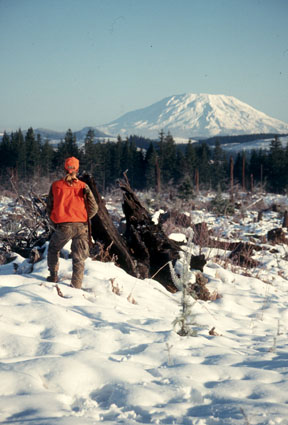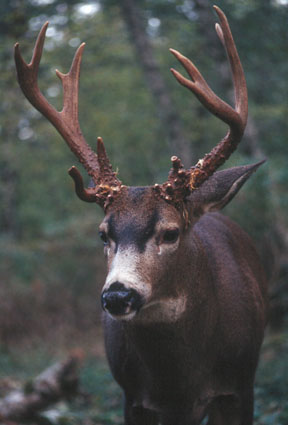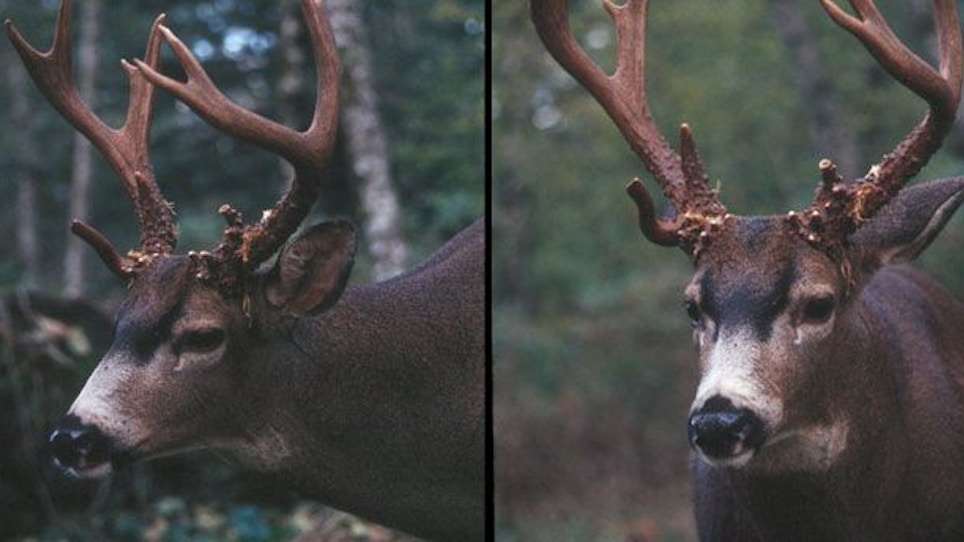 The art of rattling and grunting deer has its roots in the East. There, and in states like Ohio and Pennsylvania, hunters have for half a century experimented with the effectiveness of this technique. But it’s only been recently that blacktail hunters living in the Pacific Northwest have added this tactic to their arsenal. Certainly, some have dabbled in the art, and others have even perfected the techniques; however, many, even now in the 21st Century, are unfamiliar with the strategy as it applies to this intriguing West Coast species.
The art of rattling and grunting deer has its roots in the East. There, and in states like Ohio and Pennsylvania, hunters have for half a century experimented with the effectiveness of this technique. But it’s only been recently that blacktail hunters living in the Pacific Northwest have added this tactic to their arsenal. Certainly, some have dabbled in the art, and others have even perfected the techniques; however, many, even now in the 21st Century, are unfamiliar with the strategy as it applies to this intriguing West Coast species.
There are, however, blacktail hunters who have for years known the value of rattling and grunting. Starkey, Ore.’s Dan Kloer is one. The owner of Deep Timber Sounds (www.deeptimbersounds.com), Kloer, 56, has been chasing blacktails for the past 30 years.
“Ninety-nine percent of my blacktail hunting has been along the Oregon coast, the Saddle Mountain Range, and all the way through the Santiam area to the southern part of Oregon. The Saddle Mountain Unit has good blacktails, but it’s not easy because of the dense foliage,” said Kloer.
Kloer says when he started experimenting with rattling and calling blacktails 25 years ago, few were doing it. One of the reasons for this might be a myth. When I moved to Washington in 1993 after having spent 28 years in Ohio and hunting eastern whitetails, the common denominator I heard time after time concerning calling or rattling blacktails was “it just doesn’t work.” But how can something instinctive not work?
“It does work,” says Kloer. “I designed a call about 24 years ago, and that little call has worked for numerous blacktails. To go down in a three-day weekend and call in 15 or 16 deer was nothing. Keep in mind that 75 percent of those would be does, but in the same term, 25 percent of those would be bucks,” he continued.
Admittedly, Kloer has spent more time working on the vocal aspect of his blacktail strategies than on the rattling, and for good reason.
“The first part of the archery season can be very good for calling blacktails, but as the rut came on, we’d change to a combination of rattling and grunting,” said Kloer. “As an archer, you have a long season in September — our late season didn’t come until November or the first of December. I did take folks out and worked with them. And then we used a combination of rattling, grunting, soft mews and decoys.”
Kloer’s calling routine afield begins with setup and location.
 “I like to go to the clearcut edges and work my way down the edge, staying in the timber,” he advises. “This is what a buck will do, especially the bigger bucks. He’ll just mill around that timber edge. Nine times out of 10, these bucks won’t come from the clearcuts. They’ll come from the timber beyond you. That’s where they will have bedded.”
“I like to go to the clearcut edges and work my way down the edge, staying in the timber,” he advises. “This is what a buck will do, especially the bigger bucks. He’ll just mill around that timber edge. Nine times out of 10, these bucks won’t come from the clearcuts. They’ll come from the timber beyond you. That’s where they will have bedded.”
He continued. “I’ll set my decoy out from the clearcut edge about 25 yards. Sometimes we’ll use a cloth as a tail, so there’s a little bit of movement out there when the wind blows. Once I’m set up, I’ll start with some fawn calls — but very few fawn calls — mixed in between doe bleats. At this time, it’s the does that are attracting the bucks. It’s not necessarily buck to buck.”
One of the most frequently asked questions Kloer hears concerns calling duration.
“You’re looking at anywhere from 45 minutes to an hour in each location,” he says. “You can’t just go in there, call for five seconds, and leave. Deer often do take a long time to respond to a call, especially if they’re at a distance. Sometimes we’ll sit down, call, and have deer right on top of us, but there are more times when we’ll call for 45 minutes or an hour before something happens.”
And not waiting is where novice callers make their first mistake.
“Getting up and leaving too early — that’s the most common mistake I see,” says Kloer. “A lot of hunters, including myself when I was younger, are impatient. They want to see action right now. But blacktail hunting isn’t like hunting whitetails. With whitetails, they often hear the clang of the antlers and they come running. Blacktails are really slowed down. They’re not, what can you say, aggressive breeders.”
Now the discussion turns to rattling.
“Rattling and grunting come together as one. As bucks are pushing one another, they produce grunts and snorts. It’s just part of the fight. And as a buck’s tending a doe and following behind, he’s going to do little grunt/wheezes behind her,” said Kloer.
Kloer’s rattling sequence begins with a 30-minute quieting down period. This, as he says, “lets the woods get back to normal.” With quiet restored, Kloer will start by softly creating some dialect between a doe and her fawn. This back-and-forth exchange includes herd talk — a low-volume exchange consisting of fawn bleats combined with consoling doe responses.
Following this, Kloer begins a light rattling sequence combined with abrupt buck grunts. This creates the illusion of two bucks sizing one another up before a clash. According to Kloer, blacktails don’t do the incredibly violent crashing of antlers common among whitetail bucks, but will instead push and shove. This bulldog-style of combat, says Kloer, produces a lower volume and less violent sound.
Like calling, rattling requires not only skill but patience.
“Calling and rattling blacktails is one of the toughest things a hunter can do,” says Kloer. “Rattling in the late season is a slow issue. It’s something that has to be slowed way down. Take a good book. Sometimes you’ll be sitting there for an hour or more. Every 15 minutes or so, do a short rattle sequence mixed with tending grunts, but remember the blacktail will always take his time.”






